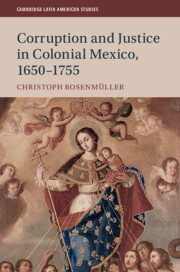(Source: CUP)
Cambridge University Press has published a
new book on corruption in colonial Mexico during the period 1650-1755.
ABOUT THE BOOK
Corruption is
one of the most prominent issues in Latin American news cycles, with charges
deciding the recent elections in Mexico, Brazil, and Guatemala. Despite the
urgency of the matter, few recent historical studies on the topic exist,
especially on Mexico. For this reason, Christoph Rosenmüller explores the
enigma of historical corruption. By drawing upon thorough archival research and
a multi-lingual collection of printed primary sources and secondary literature,
Rosenmüller demonstrates how corruption in the past differed markedly from
today. Corruption in Mexico's colonial period connoted the obstruction of
justice; judges, for example, tortured prisoners to extract cash or accepted
bribes to alter judicial verdicts. In addition, the concept evolved over time
to include several forms of self-advantage in the bureaucracy. Rosenmüller
embeds this important shift from judicial to administrative corruption within
the changing Atlantic World, while also providing insightful perspectives from
the lower social echelons of colonial Mexico.
ABOUT THE AUTHOR
Christoph
Rosenmüller, Middle Tennessee State University
Christoph
Rosenmüller is a professor at Middle Tennessee State University. His
publications include the edited volumes Corruption in the Iberian Empires:
Greed, Custom, and Colonial Networks (2017), 'Dávidas, dones y dineros':
aportes a una nueva historia de la corrupción en América Latina desde el
imperio español a la modernidad (2016), and the book Patrons, Partisans, and
Palace Intrigues: The Court Society of Colonial Mexico, 1702–1710 (2008).
TABLE OF CONTENTS
List of maps, Tables and figures
Acknowledgments
A note on terms
List of abbreviations
Introduction
1. Empire of justice
2. From judicial to administrative
corruption
3. 'This custom or better said corruption':
legal strategies and the native trade with the Alcaldes Mayores
4. 'Vile and abominable pacts': the sale of
judicial appointments and the great decline of viceregal patronage
5. Criminal process and the 'judge who is
corrupted by money'
6. Guilt and punishment for fraud, theft,
and the 'grave offense of bribery or corruption'
7. The politics of justice: Francisco
Garzarón's Visita (1716–1727)
Conclusion: approaching historical
corruption
Appendix
Glossary
Bibliography
Index.
More information
here


No comments:
Post a Comment